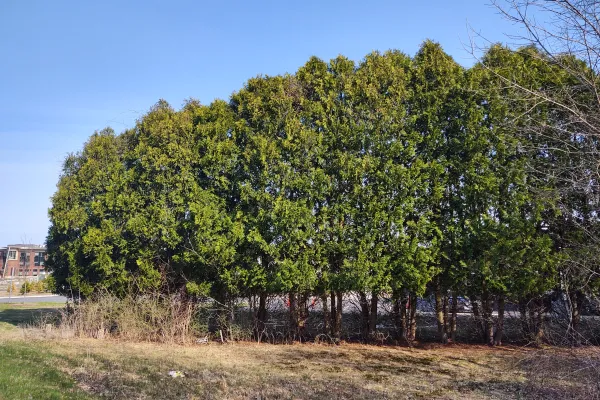Plant Pick: White Cedar (Thuja occidentalis L.)
Botanic Garden - Leaflet
Leaflet 2022

Published March 25, 2024
Also known as white cedar or northern white cedar, Thuja occidentalis ranges across Eastern North America, with a western outpost in Manitoba, Canada. Smaller populations occur in Southern New England and the Appalachian Mountains. The Botanic Garden of Smith College has nine of the more than 300 cultivars of Thuja occidentalis in commercial production planted across the campus.
Thuja is a cone-bearing genus within the cypress family (Cupressaceae). There are two North American species and three Asian species. One might wonder about the use of “occidentalis” (meaning western) for a species found in the eastern part of North America; this specific epithet distinguishes it from Asian species since, relative to the prime meridian, it is globally more westerly.
The closest North American relative to Thuja occidentalis is western red cedar (Thuja plicata), also known as giant cedar. Why is Thuja commonly referred to as cedar when true cedar is in the genus Cedrus in the Pinaceae or pine family? Frank Telewski, Professor Emeritus and Director Emeritus of the W.J. Beal Botanical Garden at Michigan State University, says, “My initial guess/suspicion… is that the wood of Cedrus, Juniperus, and Thuja all look similar macroscopically, are fragrant, and have similar respective applications in the wood products industry is the source of the common name confusion.”
Common names of plants can be incredibly confusing. There are often multiple common names for the same entity due to geographic region, language, or just individual preference. Scientific names support the notion that there is only one accepted name per species; however, it is rarely that simple. Species are often subdivided further into subspecies, varieties, sub-varieties, and forms. Then there is this to consider: Species synonyms are abandoned scientific names that are no longer considered valid. This “established” system for naming has come a long way since the time of Linnaeus, who based taxonomy on the number and arrangement of male and female organs (stamens and pistils). Today, DNA analysis provides a clearer evolutionary perspective of who is related to whom, for plants and animals.
Arborvitae, Latin for “tree of life,” is another common name for the genus Thuja. Arborvitae—and at least seven other temperate North American conifers—are high in vitamin C and a nutritional source of amino acids essential to the human diet. These conifers contain more vitamin C in their evergreen needles/leaves than lemons or oranges. This is why they were used by many indigenous communities for medicinal purposes. The Iroquois of Northeastern North America in the winter of 1535-36 provided French voyageurs with a scurvy remedy containing arborvitae that saved Jacques Cartier's critically ill crew in what is today known as Quebec City.
The curative powers of plants have been utilized since the time of early humans. Plants have been the primary sources of medicine for early drug discovery, and they still are. Recent data shows that 80 percent of 122 plant-derived drugs are still in use. There may be even more undocumented “trees of life.”